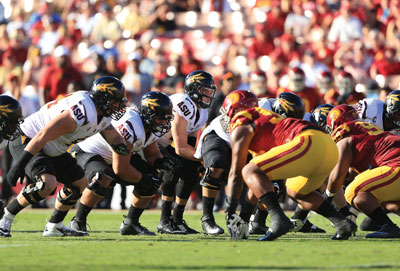Pac-12 schools could see an increase of 25 percent to 30 percent in revenue from their multimedia rights by cutting out the rights holders and forming their own in-house sales teams, conference sources say. That could mean an increase of $2 million or more in annual revenue per school.
The Pac-12 presented this new financial model to the conference’s athletic directors earlier this month during meetings at the Arizona Biltmore in Phoenix. There was no apparent consensus on how the ADs reacted to the proposal.
 |
Arizona State manages multimedia rights in-house now, but USC and the others have deals with third parties.
Photo by: GETTY IMAGES
|
At least two ADs, who didn’t want to be named, called the model to bring all sales in-house a “no-brainer” and favored a move toward adopting it. Others remain skeptical about how it would be implemented because each school, except for Arizona State, currently has its rights tied up in a contract with a third-party rights holder.
Other ADs acknowledged a “fear of the unknown” because most schools have outsourced their multimedia rights for years. Only Arizona State and Michigan State,
among the top 65 schools in the power five conferences, manage their rights in-house. The rest outsource to an agency such as IMG College or Learfield Sports.
While the input of ADs will be important in the process, the 12 university presidents
{podcast}
SBJ Podcast Archive:
From April 6: College writer Michael Smith and editor Tom Stinson talk about the Pac-12's study and how it could alter the college rights model.
ultimately will vote on the move to a new in-house model versus keeping the status quo. That’s not expected to happen until September.
In the meantime, the conference will continue working with schools individually to show them how they’d be affected and how the model would work.
Essentially, not that much would change. Each of the schools would maintain their local sales teams, which would be embedded in the school’s athletic department, just as they are now. The biggest difference is that the sales executives would work for the Pac-12 instead of an outside agency, and the schools would keep more of what they make instead of sharing revenue with the rights holder.
The conference figures that by eliminating that 25 percent to 30 percent margin for the rights holder, the schools will see significant revenue increases. Those financial projections, prepared by the conference and its consultant, San Diego-based JMI Sports, are characterized as generally conservative and come at a time when schools are under pressure to generate new revenue. Beginning with the 2015-16 academic year, schools in the Pac-12 and many others in the FBS will begin paying athletes cost-of-attendance stipends, which adds about $1 million in new expenses next season per school.
The Pac-12 office would not comment on any new developments, other than to say the process is moving forward. The league’s schools are under a moratorium through September that prohibits them from striking any new deals or extensions while they study the move to an in-house model.
Under current multimedia rights contracts, schools in the Pac-12 make from the low seven figures to the high seven figures annually from their rights holders. In the new model, revenue would still vary because schools would keep what they sell. Schools would not share multimedia revenue equally, as they do with the TV revenue that comes from ESPN and Fox Sports. Multimedia revenue comes from corporate sponsorship, in-venue signage, the radio network and other assets unique to each school.
That means the more profitable athletic departments will not have to share their multimedia revenue with the smaller schools in the league. The reasoning for that model is that some schools, like Southern California or Arizona State, are more commercially aggressive than others, like Stanford, which doesn’t sell signage in its venues. Since marketing assets change from campus to campus, there’s no expectation among the schools that they’d share multimedia rights equally, sources said.
The exception would be a category that’s sold across all 12 campuses, like the Pac-12’s wireless deal with AT&T.
While the numbers look promising, there remains work to be done to determine how the new model would be implemented. Washington and Arizona, for example, have deals in place with IMG College for the next decade. The Pac-12 theoretically would assume control of the rights as those deals expire.
If the conference moves forward with the new model, Pac-12 Sales, a recently established division of the league, likely would oversee it. The company with the most to lose if the schools go in-house is IMG College, which has deals with six Pac-12 schools — Arizona, California, Oregon, UCLA, Washington and Washington State. Learfield owns the rights at Colorado, Oregon State and Stanford, while Fox Sports has Southern Cal, and Utah works with Outfront Media Sports.




